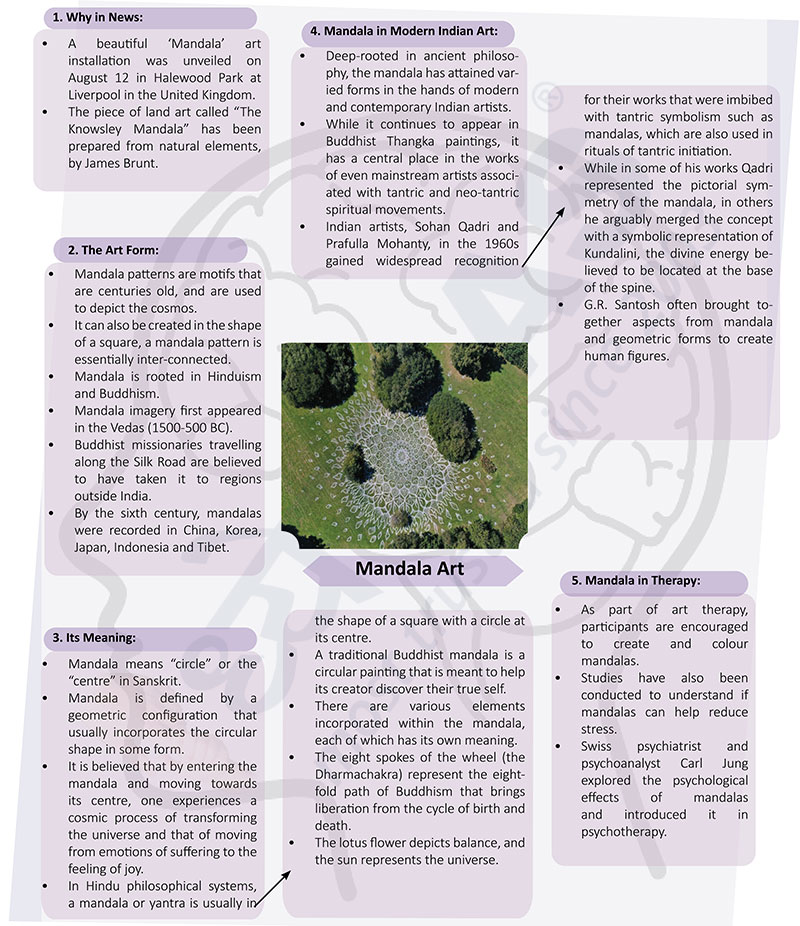Brain-booster /
20 Sep 2022
Brain Booster for UPSC & State PCS Examination (Topic: Mandala Art)

Why in News?
- A beautiful ‘Mandala’ art installation was unveiled on August 12 in
Halewood Park at Liverpool in the United Kingdom.
- The piece of land art called “The Knowsley Mandala” has been prepared
from natural elements, by James Brunt.
The Art Form:
- Mandala patterns are motifs that are centuries old, and are used to
depict the cosmos.
- It can also be created in the shape of a square, a mandala pattern is
essentially inter-connected.
- Mandala is rooted in Hinduism and Buddhism.
- Mandala imagery first appeared in the Vedas (1500-500 BC).
- Buddhist missionaries travelling along the Silk Road are believed to
have taken it to regions outside India.
- By the sixth century, mandalas were recorded in China, Korea, Japan,
Indonesia and Tibet.
Its Meaning:
- Mandala means “circle” or the “centre” in Sanskrit.
- Mandala is defined by a geometric configuration that usually
incorporates the circular shape in some form.
- It is believed that by entering the mandala and moving towards its
centre, one experiences a cosmic process of transforming the universe and
that of moving from emotions of suffering to the feeling of joy.
- In Hindu philosophical systems, a mandala or yantra is usually in the
shape of a square with a circle at its centre.
- A traditional Buddhist mandala is a circular painting that is meant to
help its creator discover their true self.
- There are various elements incorporated within the mandala, each of
which has its own meaning.
- The eight spokes of the wheel (the Dharmachakra) represent the eightfold
path of Buddhism that brings liberation from the cycle of birth and death.
- The lotus flower depicts balance, and the sun represents the universe.
Mandala in Modern Indian Art:
- Deep-rooted in ancient philosophy, the mandala has attained varied forms
in the hands of modern and contemporary Indian artists.
- While it continues to appear in Buddhist Thangka paintings, it has a
central place in the works of even mainstream artists associated with
tantric and neo-tantric spiritual movements.
- Indian artists, Sohan Qadri and Prafulla Mohanty, in the 1960s gained
widespread recognition for their works that were imbibed with tantric
symbolism such as mandalas, which are also used in rituals of tantric
initiation.
- While in some of his works Qadri represented the pictorial symmetry of
the mandala, in others he arguably merged the concept with a symbolic
representation of Kundalini, the divine energy believed to be located at the
base of the spine.
- G.R. Santosh often brought together aspects from mandala and geometric
forms to create human figures.
Mandala in Therapy:
- As part of art therapy, participants are encouraged to create and colour
mandalas.
- Studies have also been conducted to understand if mandalas can help
reduce stress.
- Swiss psychiatrist and psychoanalyst Carl Jung explored the
psychological effects of mandalas and introduced it in psychotherapy.








